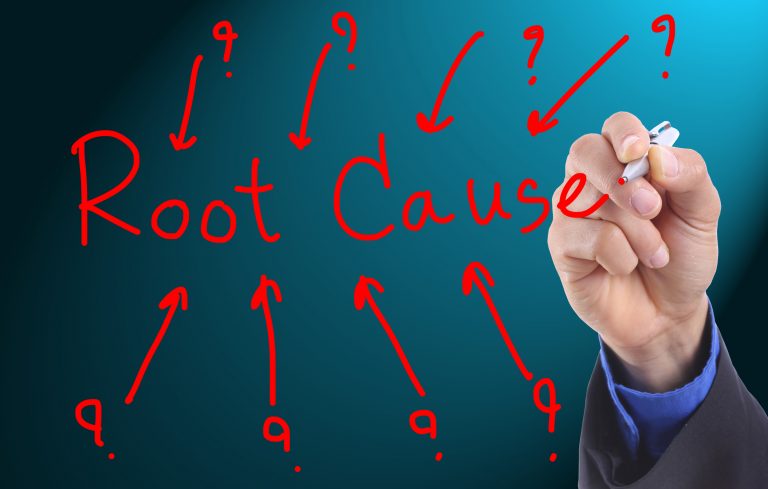How Root Cause Analysis can help a business grow?

Every month, your team seems to be working hard to meet the goals. Yet, each month, you find that your team is lagging behind.
In February, someone told you about some software glitch — so you bought new software.
In March, you heard someone say about a shortage of marketing materials was causing the problem — so you wrote a memo to the Director of Marketing, asking for a valid explanation.
In April, your team was late yet again, a team member explained that the problem is connected to a network problem — so you got the IT to get the issue fixed.
Now it’s May, and you’re looking at another missed goal. And you’re tired of putting out the fires. Something must be at the root of all the missed deadlines, and you want to figure out the root cause behind it.
This is a job of Root Cause Analysis.
“According to the Washington State Department of Enterprise Services, Root Cause Analysis is a systematic process for identifying problems or events and an approach for responding to them. It is based on the basic idea that effective management requires more than merely ‘putting out fires for problems that develop, but finding a way to prevent them.”
Root Cause Analysis Functionality
The primary purpose of Root Cause Analysis is simple. Its to determine the underlying cause for any problem and to eliminate it. The process, however, is not quite simple. There are multiple tools and techniques along the road to analyzing a root cause.
Root Cause Analysis uses four main motions, which are:
- Problem Statement: Describes the issue to be resolved.
- Data Collection: Collection of information about the nature, magnitude, location, and timing of the problem.
- Cause Identification: Exploration of the models to identify the specific actions that led to the problem.
- Action Identification: Describing the remedial action that will prevent or minimize recurrence.
Root Cause Analysis Activities
- The Fishbone Diagram: A fishbone diagram which is also known as an Ishikawa or cause-and-effect diagram is used to identify and organize the potential causes of a problem. Read our blog on Ishikawa Diagram to get a detailed insight.
- The 5 Whys: The five whys is a question asking process to investigate the nature and cause of a problem. The five whys strategy involves repeatedly asking the same questions in order to identify the root cause of the problem. It is one of the easiest tools used when problems have a human interaction component.
Implementing RCA will help your Business by:
- Identifying barriers and the causes of problems, so that a permanent solution can be found.
- Developing a logical approach to problem-solving, using existing data.
- Recognizing current and future needs and trends for organizational improvement.
- Establishing repeatable, step-by-step processes, in which one process can vouch for the results of another.
Root Cause Analysis Best practices for Businesses
Specific best practices should be viewed while performing RCA. Adopting these best practices ensures the identification of the root cause of the problem and helps define specific and sustaining restorative actions.
- Focus on rectifying the actual cause of the problem rather than beating around the bush as there could be multiple root causes that might be interrelated.
- Question the ‘PROCESSES’ and not people.
- Tackle the problem methodically to find concrete evidence to back up the root cause claims.
- The people engaging in the analysis should have a sound knowledge of the different RCA methods, techniques, tools and their application.
- The identified root cause should have the consent of the team participating in the analysis activity.
- The implementation cost should be kept in mind while planning a solution to a problem.
- Visualize your data for quick analysis and investigation.
- The entire process should be supervised by a facilitator having past experience conducting and guiding RCAs.
In case, we have one of the popular quality management certification courses that individuals and enterprise teams can take up to learn and implement RCA:
What You Will Receive:
- Access to the online Root Cause Analysis training for 90 days in our online Learning Center portal
- Access to the online RCA manual, delivered using LockLizard for secure access
- Downloadable library of RCA templates and files to use and modify as you see fit
- Certificate of completion upon successfully passing the final comprehensive exam
Summary
Often times in business, the problem is not the actual problem. Root Cause Analysis via quality data enables a company to identify, understand, and correct the problem at the source, instead of fixing surface-level issues. Identifying and classifying determinants through techniques like focus groups, interviews and surveys play an important role in solving the root cause problem and results in long-term success for any business.
SixSigma.us offers both Live Virtual classes as well as Online Self-Paced training. Most option includes access to the same great Master Black Belt instructors that teach our World Class in-person sessions. Sign-up today!
Virtual Classroom Training Programs Self-Paced Online Training Programs







